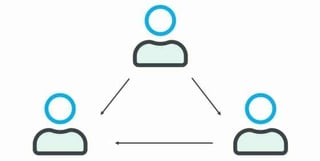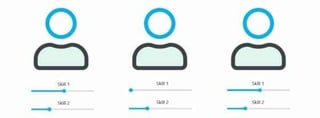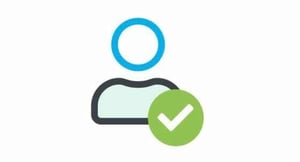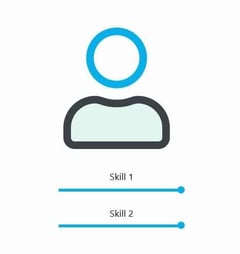Automatic call distribution (ACD; often referred to as call routing), refers to the strategy of using a computerized phone system to receive incoming calls and transfer them to the right place according to predefined rules and criteria. Automatic Call Distributors are the heart of contact centers and allow organizations to manage high call volumes through an optimal utilization of human resources. They quickly connect customers to the right employees or services and thereby reduces the callers' hold time, improve agent productivity, and increases the first-call resolution. There are many ways to route calls, and the right strategy will depend on your personal business needs and goals.
Call Qualification
A call has to be qualified before it can be routed to the responsible employee or service. This can be done in one of three ways:
Manual Call Transfer
In some cases, such as in small companies or in the case of a reception desk, it can make sense to have a manual call transfer. In a manual call transfer, an employee infers information about the caller by looking at the caller’s history or by speaking to the caller. After collecting enough information, the employee transfers the caller to the relevant employee or service within the company. This type of routing is very personal and offers great customer satisfaction but also requires enough staff to take on the calls. A caveat is that the caller is not connected to the responsible employee or service right away. To make manual call transfers more efficient, it can be useful to employ software such as the Luware Nimbus Attendant Console for Microsoft Teams, which displays a neat overview of relevant context information such as the caller’s name and ticket history as well as employees’ calendars and presence states.
Benefits:
Downsides:
- Labor-intensive,
- no first-contact resolution
Hunt Groups
A hunt group transfers calls from a single phone line to a group of phone numbers within an organization. For example, calls to the Sales service number are distributed to the individual phone numbers of the Sales employees, who are part of the Sales hunt group. Hunt groups remove the need for receptionists, but require that every service, such as Marketing or Sales, has a separate phone number. Calls within the hunt group can be distributed to the hunt group members through several call distribution strategies, which are explained further down. This type of routing is useful for smaller organizations, where every department has a separate service line and where employees generally only serve one Team.
Benefits:
- Effective for simple use cases such as internal help desks, Sales, Backoffice
- Easy to add users to a service line
Downsides:
-
No distinction between users within a service line (e.g. how well they speak a language)
-
Can become very complex to route calls according to skills as a separate team has to be created for every skill category
Interactive Voice Response (IVR)
An IVR is an automated phone system feature that allows callers to enter commands through spoken word or by pressing keys on their phone. The caller is consequently routed to the right place according to these inputs. You have probably experienced an IVR in the form of one of these types of voice menus: “For product inquiries, press 1. To enroll in a new banking service, 2. For general assistance, press 3.” By pressing the number(s) that correspond to your inquiry, you navigate through a decision tree, until you reach a call queue, which then gets distributed to a responsible employee or service. IVRs have been around for over 30 years and sometimes receive a bad reputation as they are impersonal and disliked by customers. However, well set up IVRs can be very time- and cost-efficient. IVRs also offer a high amount of agility, which is essential to delivering great customer service, as organizations must quickly adapt to changes in the market, volatile call volumes, and internal resources. Even after over 30 years and new technology in the form of AI and bots, IVRs often still outperform newer technologies in many situations. The simplicity of IVRs enables self-service for business departments to quickly market, resulting in a high speed-to-market.
Benefits:
Downsides:
- Impersonal
- disliked by customers
Parameter-dependent Routing
IVRs can be shortened by using parameter-dependent routing to take caller information into consideration. Readily available caller data from sources such as technical properties of the call or an external CRM can be used to shorten customer wait times and to connect customers with the right employee or service faster. For example, the caller number could be used to find out the region of origin, or the number could be checked in a CRM to gain information about pending orders to consequently connect the caller with the responsible employee or service. With Luware Nimbus Enterprise Routing and Luware Nimbus Contact Center you can take routing decisions based on any data sources provided via Microsoft Power Automate.
Use cases are manifold. Some examples include:
- Connect callers to a service team from their region based on their area code, e.g. Sales Team Germany
- Automatically connect callers with open orders in CRM to the service line responsible for orders
- An Employee Hotline that connects employees to different HR services based on their position (employee/manager/C-level),
Benefits:
- Low wait times
- high customer satisfaction
Downsides:
- Requires enough and accurate data
Call Distribution
Call routing defines the route that a call takes to reach the final queue or distribution point. Once the call has reached the relevant queue, the call distribution defines which employees or services are now responsible for taking the call.
Fixed list of users

Calls are distributed to employees in a fixed, preset order. This type of distribution is useful if you want to prioritize certain employees within the call queue. Each new call is distributed to the first employee in the list and the call be distributed the next employee down the list if the first employee is unavailable. There is a single distribution profile and if the last employee in the list does not pick up, the caller has to be rerouted to an alternative queue or to a voicemail.
Round Robin

In a round robin distribution, calls are equally distributed among all employees. This type of distribution works well for generalized requests, where there is no need for specialized agents. Employees take turns answering the calls. For example, Employee 1 takes the first call, employee 2 the second, etc. until every employee has taken a turn answering a call. Then the cycle repeats.
Skill-based

Instead of simply choosing the next fixed group of agents, skill-based distribution transfers calls to a suitable employee by matching the skills required to perform a task (as defined in the call qualification stage) to the employees’ skills. Skill categories are most often used for language ability, location or product knowledge and can be broken down into as many or few skill levels as desired. For example, the skill Location could be ‘Zurich’, ‘London’ or ‘Vienna’. Meanwhile, the skill language could be ‘German’, ‘French’, and ‘English’, where each skill is further broken down into the skill levels ‘Beginner’, ‘Specialist’ and ‘Native’. Skill-based distribution can be set up in the Luware Nimbus Contact Center. This type of distribution is useful to manage a large number employees with different skills and skill levels and facilitates user training. A distribution policy with multiple distribution profiles also make it possible to extend the search group and to add or remove certain skills and levels with increasing wait time. Therefore, the system does not have to reroute the call to an alternative queue and can instead simply extend the group of responsible employees. If more than one employee with the matched skills and according level is available, a call distribution strategy will define how calls are distributed.
Longest idle

In a longest idle distribution, the call is distributed to the employee that has been available, i.e. has not taken a call, for the longest. The idle time resets each time a call or after-work call time ends and every time the user becomes available again after being unavailable or offline.
Best / Least Qualified

One type of distribution that is unique to skill-based routing is a best/ least qualified distribution. In this type of distribution, the call gets distributed to the person with the highest or lowest skill(s).
Looking for a routing solution?
We offer a variety of routing solutions that are tailored to different use cases and needs.
▶️ Explore Luware solutions.

